Lebanon’s property market improving
 After two years of house price falls, Lebanon’s property market is improving. House prices are now rising. Demand is also increasing gradually. This is a bit surprising given Lebanon´s timid economic growth, continued domestic political bickering and the ongoing war in neighboring Syria.
After two years of house price falls, Lebanon’s property market is improving. House prices are now rising. Demand is also increasing gradually. This is a bit surprising given Lebanon´s timid economic growth, continued domestic political bickering and the ongoing war in neighboring Syria.
During the year to end-Q3 2016, the average value of property transaction in Lebanon rose by 4.71% to US$133,446 from a year earlier, according to the Directorate of Real Estate and Cadastre.
By region:
- Beirut, which has the most expensive housing in Lebanon, saw its property prices rising by 5.63% y-o-y in Q3 2016, to an average of US$538,546
- In Metn, property prices rose by 3.81% during the year to Q3 2016, to US$213,350
- In Baabda, property prices increased 11.7% y-o-y in Q3 2016 to US$150,474
- In Kesserwan, property prices fell by 11.09% y-o-y to an average of US$124,628
During the first ten months of 2016, the number of property sales in Lebanon increased 1.2% y-o-y to 51,707 units, according to the Directorate of Real Estate and Cadastre. Likewise, the value of property sales transactions also rose by 2.9% y-o-y to LBP10 trillion (US$6.65 billion)over the same period.
The Lebanese property market saw an average annual growth of 18% (13% inflation-adjusted) from 2009 to 2013, before slowing sharply due to regional political turmoil.
- In 2009, average property sales prices rose by about 48.4% y-o-y (43.5% inflation-adjusted)
- In 2010, average property sales prices increased by 7.37% y-o-y (2.7% inflation-adjusted)
- In 2011, average property prices rose by 9.8% y-o-y (6.5% inflation-adjusted)
- In 2012, average property prices rose by 6.25% y-o-y (-3.51% inflation-adjusted)
- In 2013, average property sales prices rose by 16% y-o-y (14.7% inflation-adjusted)
- In 2014, average property sales prices dropped 1.61% (-3.87 inflation-adjusted)
- In 2015, average property sales prices dropped slightly by 0.8% (increased 3.1% inflation-adjusted)
House prices in several areas of Lebanon doubled from 2008 to 2012, mainly due to increased demand from GCC investors after the oil price surge in 2008.
However since then prices have slumped. In addition, the Lebanese economy grew by just 1% in 2015, after GDP growth of only 2% in 2014, 2.5% in 2013, 2.8% in 2012 and 0.9% in 2011, based on figures from the International Monetary Fund (IMF). The Lebanese economy remains weak, with projected GDP growth of just 1% this year.
Surprisingly, tourism improved in the past two years. The number of tourist arrivals rose by 12.1% y-o-y to 1,518,000 persons in 2015, after rising by 6.3% the previous year. The number of tourist arrivals dropped by an average of 16% per year from 2011 to 2013.
Foreign ownership of real estate property is allowed in Lebanon. Foreigners can acquire up to 3,000 square meters (sq. m) of land. For properties bigger than this, a prior decree from the Council of Ministers is needed. Foreigners can only own up to 3% of the total land area of Lebanon, except in Beirut, where foreigners can acquire up to 10% of the city´s total area.
Buyers are looking outside Beirut
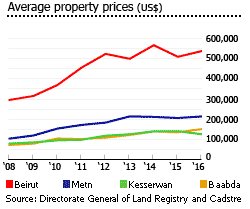
Beirut’s property prices are exceptionally high, about four times the national average. So homebuyers have been moving out from Beirut, the capital, to cheaper housing. During the first eight months of 2016, Beirut accounted for just about 26.4% of the total value of property transactions, down from about 37.2% in 2007, based on figures from the Real Estate Registry.
Less expensive nearby areas, such as Baabda, Metn, and Kesrouan accounted for almost 52% of total property sales in the first seven months of 2015, up from about 47% in 2007.
Property prices and sales transactions in Lebanon are expected to continue falling in the coming months, according to local property experts.
Conflict-stricken economy

Lebanon´s religious communities maintain a watchful equilibrium. To maintain the balance of power between religious groups, the president must be a Maronite Catholic Christian, the prime minister a Sunni Muslim, the deputy prime minister an Orthodox Christian and the speaker of parliament a Shi’a Muslim. The 128 parliamentary seats are equally divided between Christian and Muslims.
The country’s economy was ravaged during the Lebanese Civil War from 1975 to 1990. From the 1990s to the early-2000s, there was an uneasy calm, with external forces and militant groups occupying different parts of the country.
In 2005, former Prime Minister Rafik Hariri was assassinated. Then in July 2006, the Israel-Hezbollah War erupted, which caused large-scale damage to Beirut, undoing much of the good work done in the post-Civil War reconstruction programme. In May 2007, the violent Nahr al-Bared conflict, the most severe internal fighting in almost two decades, exploded and ravaged some parts of the country.
Finally in May 2008, the Doha Accord marked the end of an 18-month long political crisis. Local political and security conditions improved considerably, with the Lebanese government determined to pursue reforms focused on achieving economic revival, sustainable growth and political stability.
The political stability in the country helped the economy grow strongly, with an average annual GDP growth rate of 9.2% from 2007 to 2010.
However the Syrian conflict that erupted in March 2011 spilled over into Lebanon, causing deadly clashes between Sunni Muslims and Alawites in Tripoli and Beirut. Lebanon’s economy slowed sharply, with GDP growth rates of just 0.8% in 2011.
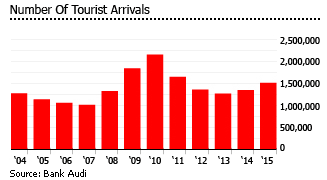
Political tensions brought down the government of Prime Minister Saad al-Hariri in January 2011. He was succeeded by Najib Mikati, whose cabinet is dominated by Hezbollah and its allies.
In June 2011, the UN issued arrest warrants for four members of Hezbollah in the murder of former PM Rafik Hariri. Hezbollah was uncooperative and refused to allow any suspects to be arrested. Tensions were exacerbated by the Arab Spring which began in December 2010.
By mid-2012, the Syrian conflict which began in March 2011 had spilled over into Lebanon in deadly clashes between Sunni Muslims and Alawites in Tripoli and Beirut. This raised fears that Lebanon’s already fragile political truce could collapse again into sectarian strife. The number of Syrian refugees in Lebanon rose to over one million in April 2014 from about 700,000 people in September 2013. With a population of just 4.5 million, this means that one in every five people in the country is a Syrian refugee. This has placed a severe strain on the country´s resources.
Then in March 2013, Najib Mikati’s government resigned amidst political tensions over upcoming elections. General elections, due last November 2014, were put on hold until 2017 due to security concerns over the conflict in Syria.
Economic growth has slowed sharply in the past four years, with annual GDP growth rates of just 1% in 2015, 2% in 2014, 2.5% in 2013, and 2.8% in 2012.
In October 2016, Michel Aoun was elected by parliament, ending a political stalemate that left Lebanon without a head of state since May 2014.
Property sales rising gradually
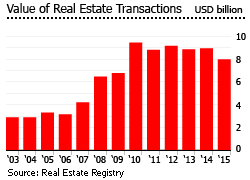
During the first ten months of 2016, the number of property sales in Lebanon increased 1.2% y-o-y to 51,707 units, according to the Directorate of Real Estate and Cadastre. Likewise, the value of property sales transactions also rose by 2.9% y-o-y to LBP10 trillion (US$6.65 billion)over the same period.
From January to October 2016:
- In Beirut, the value of property transactions rose by 7.5% y-o-y to US$1.7 billion
- In the South, property transactions soared 18.4% y-o-y to US$471 million
- In Baabda, the value of property transactions rose by 15.1% y-o-y to US$1.63 billion
- In Bekaa, property transactions rose 2.7% y-o-y to US$239 million
- In the North, the value of property transactions increased slightly by 1.5% y-o-y to US$473 million
- In Metn, the value of property transactions fell by 5.8% y-o-y to US$1.19 billion
- In Nabatieh, property transactions dropped 10.3% y-o-y to US$192 million
- In Kesserwan, property transactions value plunged 17.5% y-o-y to US$691 million
Foreign demand remains depressed
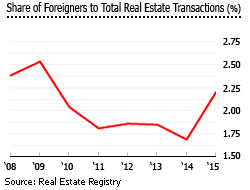
Property investments by foreigners and other Arab nationals remain depressed, amidst the continued regional political unrest, particularly in neighboring Syria. During the first ten months of 2016, there were 859 real estate transactions by foreigners, down by 24.2% from the same period last year, according to the Real Estate Registry.
In the first ten months of 2016, foreign homebuyers represented about 1.7% of total property transactions, from 2.2% in 2015, 1.69% in 2014, 1.85% in 2013, 1.86% in 2012, 1.81% in 2011, 2.04% in 2010 and 2.53% in 2009.
The biggest risk - falling rental yields
Gross rental yields in Beirut have been falling. Gross rental yields on Beirut apartments now range from 3.45% to 4.5%, very significantly down from an average of 10% to 11% about six years ago. Larger apartments in Beirut have lower yields.
The continuous decline in rental yields can be attributed to the dramatic increase in house prices in recent years.
The average monthly rents in Beirut ranged from LBP3.14 million (US$2,082) for 150 sq. m. apartments, to LBP8.12 million (US$5,380) for 400 sq. m. apartments, according to the Global Property Guide’s research.
Average rents for the market as a whole are lowered by the survival of many pre-1992 contracts, creating a class of sitting tenants paying low rents, who cannot be evicted except at great cost (see Lebanon’s Landlord and Tenant Law). However this law does not affect post-1992 contracts, which are equally balanced between landlord and tenant. (The Global Property Guide’s research only covers current offers for sale and offers to rent, not pre-existing contracts).
Construction activity falling
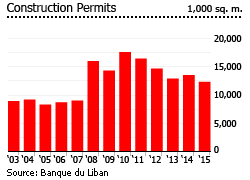
In 2015, new construction permits fell by 8.9% to 12.34 million sq. m. from a year earlier, after a modest growth of 4.8% in 2014 and annual declines of 12% in 2013, 10.8% in 2012, and 6.5% in 2011, based on figures from Banque Du Liban and the Order of Engineers. Of total permits, 81.4% were for the construction of residential buildings.
All regions saw a decline in construction activity in 2015.
- In Beirut, the area of construction permits dropped 29% y-o-y in 2015, to 668,000 sq. m.
- In North Lebanon, the area of construction permits fell by 12% y-o-y in 2015, to 2.21 million sq. m.
- In South Lebanon, the area of construction permits fell by 8% y-o-y in 2015, to 1.52 million sq. m.
- In Nabatieh, construction permits fell by 7% y-o-y in 2015, to 1.03 million sq. m.
- In Bekaa, construction permits fell by 7% y-o-y in 2015, to 1.01 million sq. m.
- In Mouth Lebanon, construction permits fell by 6% y-o-y in 2015, to 5.91 million sq. m.
During the first ten months of 2016, the area of construction permits issued dropped by another 2.2% to 10.06 million sq. m. from the same period last year.
The total number of construction permits in the country rose by an average of 16.4% annually from 2005 to 2010.
Major residential developments
Some major new residential developments in Lebanon:
BeitMisk
BeitMisk is a huge $800 million residential community project in the mountainous Northern Metn region, covering more than 655,000 sq. m., and expected to house around 15,000 residents.
Announced in mid-2009, BeitMisk offers apartment units, villas and penthouses to homebuyers. It also offers a country club, gardens, recreational areas, and retail stores. The first batch of apartments is already available in the market. In 2015, the selling price of two- to three-bedroom apartments starts at US$2,000 per sq. m.
Beirut Terraces
The Beirut Terraces is a 116 metre-high structure which offers a mix of apartments of different sizes and types such as simplex, duplex and townhouses with pools. The construction of the project was started in 2011 and is now near completion. Currently, a luxury penthouse has a price tag of US$13 million.
Beirut Towers
The Beirut Towers is a US$125 million luxury residential development in Beirut launched by Plus Properties, a Dubai-based developer. The residential project, completed recently, consists of two 23-storey towers, named Verdun and Ashrafieh—two of the most prestigious residential neighborhoods in the city. The two towers offer studio, one and two-bedroom apartments on single or duplex floors.
Venus Towers
This US$500 million residential development was launched last September 2009 by Venus Real Estate Development Co., and stretches over 7,510 metres in Marina, Solidere in Beirut.
The development is surrounded by 3,500 sq. m of gardens, jogging tracks and playgrounds.
Venus Towers has 3 luxurious residential buildings—Bloc A-30-storey; Bloc B-26-storey; and Bloc C-20-storey. Apartments range from 250 sq. m to 650 sq. m. Amenities include a swimming pool, gymnasium, guest parking spaces, a commercial area and a security.
Marina Towers
The Marina Towers, completed in 2007, is a residential complex near the Beirut Marina. The development consists of the Marina Tower, Marina Court, and Marina Garden. The Marina Tower is the highest among the three buildings, at 150-m height built on over 7,000 sq. m land. On the other hand, the Marina Garden, surrounded by over 3,000 sq. m gardens, and the Marina Court, offers relatively smaller apartment units.
Sama Beirut
Launched in August 2009 by Antonios Projects, Sama Beirut is a 50-storey mixed use project located in Ashrafieh, near downtown Beirut. The project has been fully-operational since 2014.
Its 200-m skyscraper, the tallest building in the country, offers residential, commercial and retail space. Its residential apartments range from 300 sq. m to 1,500 sq. m. In addition, the tower also features six commercial shops and office spaces.
Platinum Towers
Platinum Towers, at 153-metres, is one of Lebanon’s tallest residential buildings. The US$200 million residential project, completed in 2008, is in the heart of Beirut’s dynamic central district, along the Beirut Marina. It is only a few minutes away from Beirut International Airport.
Platinum Towers consists of two buildings. The smaller one is by the sea, the other overlooks Beirut Central District.
Mortgage market slowing sharply
In Lebanon, buyers have traditionally paid cash, or benefited from pre-selling schemes. They buy during construction, making down payments and then paying in monthly installments. Housing were traditionally only available to developers.

Starting mid-2000s, there were an increasing number of banks offering mortgage loans directly to homebuyers. As a result, the size of the Lebanese mortgage market grew to 19.2% of GDP in 2014, from 17.9% in 2013 and an average of just 5.7% from 2004 to 2009.

In 2015, outstanding housing loans increased 7.33% to LBP16 trillion (US$10.6 billion) from a year earlier, according to the Banque du Liban. This was a sharp slowdown from an average annual housing loan growth of more than 30% from 2006 to 2014. The total amount of new housing loans drawn actually fell by 23% to LBP1.57 trillion (US$1.04 billion) in 2015.
In September 2016, the repo rate was kept at 10%, unchanged since December 2009.
Interest rates for housing loans are usually tied to the US prime rate or LIBOR, with a fixed percentage added. The loan-to-value (LTV) ratio ranges from 50% to 85% of the appraised value or actual purchase price of the property, whichever is lower. The term period is usually from 20 to 30 years. Lebanese banks require both life and house insurance from loan applicants.